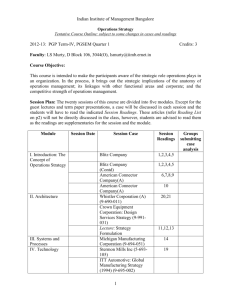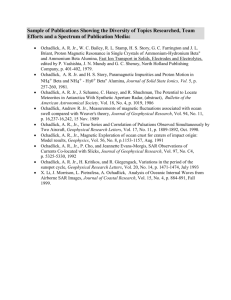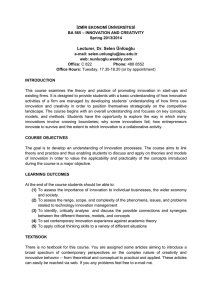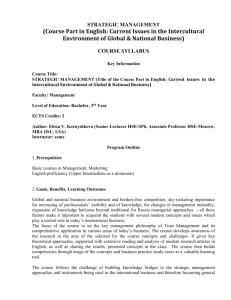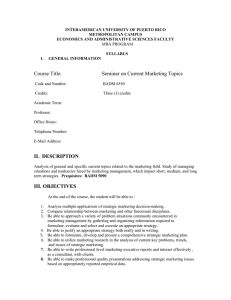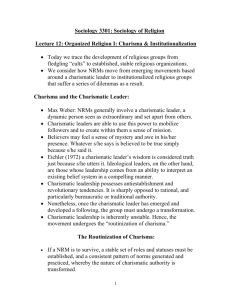Syllabus
advertisement
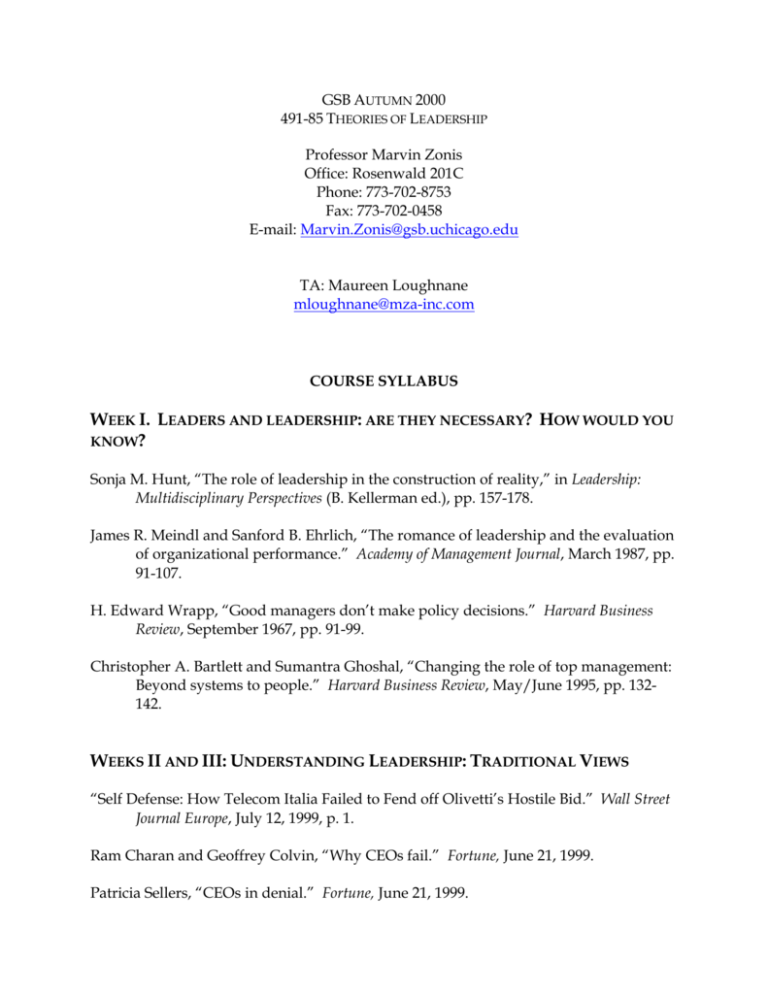
GSB AUTUMN 2000 491-85 THEORIES OF LEADERSHIP Professor Marvin Zonis Office: Rosenwald 201C Phone: 773-702-8753 Fax: 773-702-0458 E-mail: Marvin.Zonis@gsb.uchicago.edu TA: Maureen Loughnane mloughnane@mza-inc.com COURSE SYLLABUS WEEK I. LEADERS AND LEADERSHIP: ARE THEY NECESSARY? HOW WOULD YOU KNOW? Sonja M. Hunt, “The role of leadership in the construction of reality,” in Leadership: Multidisciplinary Perspectives (B. Kellerman ed.), pp. 157-178. James R. Meindl and Sanford B. Ehrlich, “The romance of leadership and the evaluation of organizational performance.” Academy of Management Journal, March 1987, pp. 91-107. H. Edward Wrapp, “Good managers don’t make policy decisions.” Harvard Business Review, September 1967, pp. 91-99. Christopher A. Bartlett and Sumantra Ghoshal, “Changing the role of top management: Beyond systems to people.” Harvard Business Review, May/June 1995, pp. 132142. WEEKS II AND III: UNDERSTANDING LEADERSHIP: TRADITIONAL VIEWS “Self Defense: How Telecom Italia Failed to Fend off Olivetti’s Hostile Bid.” Wall Street Journal Europe, July 12, 1999, p. 1. Ram Charan and Geoffrey Colvin, “Why CEOs fail.” Fortune, June 21, 1999. Patricia Sellers, “CEOs in denial.” Fortune, June 21, 1999. Robert J. House and Ram N. Aditya, “The social scientific study of leadership: Quo vadis?” Journal of Management vol. 23, no. 3 (1997), 409-473. David A. Nadler and Michael L. Tushman, “Organizational frame bending: principles for managing reorientation.” The Academy of Management Executive, vol. III, no. 3 (1989), pp. 194-204. WEEK IV: THE ORGANIZATION AND THE INDIVIDUAL Sigmund Freud, Group Psychology and the Analysis of the Ego, pp. 69-143. Otto F. Kernberg, “Leadership and organizational functioning: Organizational regression.” International Journal of Group Psychotherapy, vol. 28, no. 1 (1975), pp. 3-25. WEEK V: BUSINESS LEADERSHIP: CHARISMATIC AND UNCHARISMATIC Richard E. Hattwick, “Mary Kay Ash.” Journal of Behavioral Economics, Winter 1987, pp. 61-70. John P. Kotter and John Stengrevics, “Mary Kay Cosmetics, Inc.” Harvard Case, January 1981, pp. 1-13. Patricia Sellers, “What exactly is charisma?” Fortune, January 15, 1996. WEEK VI: CHARISMA: THEORETICAL PERSPECTIVES Jerome A. Winer, Thomas Jobe, and Carlton Ferrono, “Toward a psychoanalytic theory of the charismatic relationship.” Annual of Psychoanalysis, vol. XII/XIII (January 1984), pp. 155-175. Charles Camic, “Charisma: its varieties, preconditions and consequences.” Journal of Sociological Inquiry, vol. 50 (1980), pp. 5-23. Boas Shamir, “The charismatic relationship: Alternative explanations and predictions.” Leadership Quarterly, vol. 2, no. 2 (Summer 1991), pp. 81-104. WEEK VII: NARCISSISM AND SELF-OBJECTS Heinz Kohut, “The Separate Developmental Lines of Narcissism and Object Love.” Chapter 2 in Miriam Elson (Ed.) The Kohut Seminars. W.W. Norton and Company, 1987, pp. 18-30. Heinz Kohut, “Early Stages in the Formation of Self-Esteem.” Chapter 3 in Miriam Elson (Ed.) The Kohut Seminars. W.W. Norton and Company, 1987, pp.31-46. John T. Marcus, “Transcendence and charisma.” Western Political Quarterly, March 1961, pp. 236-241. Jerrold M. Post, “Narcissism and the charismatic leader-follower relationship.” Political Psychology, vol. 7, no. 4 (December 1986), pp. 675-688. WEEK VIII: POLITICAL LEADERSHIP: THE SHAH OF IRAN Marvin Zonis, Majestic Failure: The Fall of the Shah of Iran. Pages 1-22, 61-82, 115-165, 207257. Chicago: University of Chicago Press, 1991. WEEK IX: MILITARY-POLITICAL LEADERSHIP: ADOLF HITLER Walter C. Langer, The Mind of Adolf Hitler. Basic Books, 1972. Pages iv-306. WEEK X: FEMINIST PERSPECTIVES AND CONCLUSION Susan J. Carroll, “Feminist scholarship on political leadership.” Chapter 7 in Leadership: Multidisciplinary Perspectives (B. Kellerman, Ed.). Pages 139-156. Prentice-Hall 1984. Judy B. Rosener, “Ways women lead.” Harvard Business Review, 1990, pp. 119-125. John Holusha, “Grace Pastiak’s ‘web of inclusion.” New York Times, Sunday, May 5, 1991. Kathy E. Kram and Marion McCollom Hampton, “When women lead: the visibilityvulnerability spiral.” Chapter 8 in Edward Klein, Faith Gabelnick and Peter Herr (Eds.), The Psychodynamics of Leadership, pp. 193-218. Madison, CT: Psychosocial Press, 1998.




